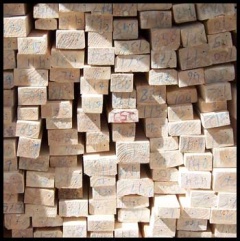Balsa Wood
| Infobox on Balsa Wood | |
|---|---|
| Example of Balsa Wood |  |
| Facts | |
| Origin | Central-South America |
| Stowage factor (in m3/t) | 9,36 m3/t (bundles) |
| Humidity / moisture | - |
| Ventilation | - |
| Risk factors | See text |
Balsa Wood
Description
Ochroma pyramidale, commonly known as the balsa tree (also O. lagopus), is a species of flowering plant in the mallow family, Malvaceae. It is a large, fast-growing tree that can grow up to 30 m (100 ft) tall. Balsa wood is a very lightweight material with many uses. Balsa trees are native to southern Brazil and Bolivia north to southern Mexico.
Ecuador supplies 95 percent or more of commercial balsa. In recent years, about 60 percent of the balsa has been plantation grown in densely packed patches of around 1000 trees per hectare (compared to about two to three per hectare in nature). It is evergreen, or dry-season deciduous if the dry season is long, with large (30–50 cm) weakly palmately lobed leaves. Trees are classified as hardwood because of the shape of their leaves, so balsa, with its large, broad leaves is classified as hardwood despite being very soft. It is the softest commercial hardwood. The trees are harvested after six to 10 years of growth. The name balsa comes from the Spanish word for "raft".
Application
Balsa lumber is very soft and light, with a coarse, open grain. The density of dry balsa wood ranges from 40–340 kg/m3 (2.5–21 lb/ft3), with a typical density of about 160 kg/m3 (10 lb/ft3).[3] The light weight of the wood derives from the fact that the tree has large cells that contain water. After the water is driven off in an extended drying process (kiln dried for two weeks), the large surface area of the resulting holes gives strength. Unlike dry rotted wood, the surface is made of the usual strong cellulose/lignin mix. As it is low-density but high in strength, balsa is a very popular material to use when making light, stiff structures in model bridge tests, model tree houses, and for the construction of model aircraft, as well as full-sized light wooden aeroplanes, most famously the World War II de Havilland Mosquito. Balsa is used to make wooden crankbaits for fishing.
Balsa wood is often used as construction material for radio controlled model aircraft and as a core material in composites; for example, the blades of many wind turbines are made partially of balsa. In table tennis paddles, a balsa layer is typically sandwiched between two pieces of thin plywood. Balsa wood is also used in laminates with glass-reinforced plastic (fiberglass) for making high-quality balsa surfboards and the decks and topsides of many types of boats, especially pleasure craft under 30 m (100 ft) in length. Starting with the 5th generation Chevrolet Corvette, the floor pan of the Corvette was composed of balsa sandwiched between two sheets of carbon fiber reinforced plastic. Norwegian scientist/adventurer Thor Heyerdahl, convinced that early contact between the peoples of South America and Polynesia was possible, built the raft Kon Tiki from balsa logs, and upon it he and his crew sailed the Pacific Ocean from Peru to the Polynesian Tuamotu Archipelago in 1947. Balsa wood is also a popular wood type used in the art of whittling.
Shipment / Storage / Risk factors
Easily damaged by crushing or wetting. Should not be overstowed with heavy goods and kept away from those which are moist or oily.











